
Though Best Brains had two seasons of Mystery Science Theater 3000 under their belt, getting renewed was still not a sure thing. While a loyal fan base had been established, this did not necessarily translate into stellar viewing figures. Even considering that cable tended to be more forgiving of ratings that would get a broadcast network show cancelled, it was 50-50 on whether or not a third season was in the cards. And then a late Christmas Miracle occurred.

A freelance reporter and fan of the show by the name of Chris Cornell pitched the idea of an article about MST3K to the Philadelphia Inquirer and got the go-ahead. The editors of TV Guide (which was based in Philadelphia at the time) saw the article and reprinted it. This in turn brought the show to the attention of a wide variety of media outlets, creating a publicity cascade. Thanks to this, Comedy Central presented an offer of four seasons with 24 episodes each.

There were also some shifts in personnel. Possibly due to the increased workload in his producer duties, Jim Mallon went from being a full writer to a contributing writer (meaning he’d watch the movie at home and send in his own riff ideas rather than take part in the group viewings). Bridget Jones-Nelson and Paul Chaplin also joined the writing staff during this season, initially as contributing writers for several episodes before joining in the group viewings. Bridget even made her on-screen debut in Gamera vs Zigra as one of the annoying brats from the movie.
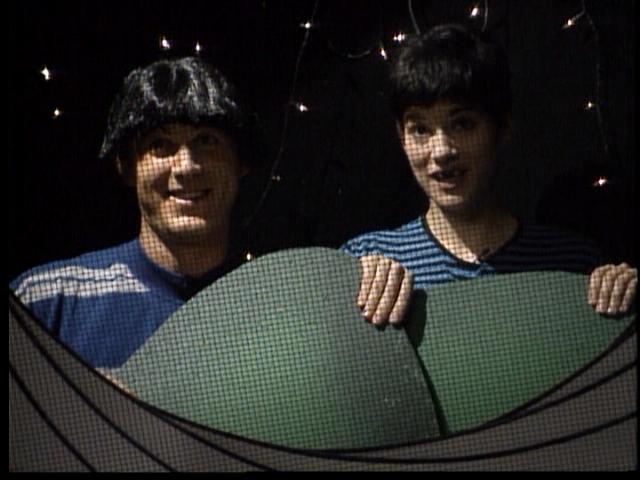
In the movie selection, we got quite a few firsts. The first Pecs & Pulchritude fantasy film. The first slasher flick. The first Roger Corman film. The first Christmas film. This was also the period when they presented educational shorts in earnest. But this also proved to be the most nostalgic season. Back in the KTMA days, they screened eleven entries from a package of movies imported by Sandy Frank, most of which were Japanese (the Soviet produced Humanoid Woman being the lone exception). In this season, the Brains got to revisit nine of those titles, including five installments of the kaiju franchise featuring everyone’s favorite giant flying turtle Gamera.

But enough of that. We have a hinderload of material to get through, so let’s get cracking.

301: Cave Dwellers [Grade: A]
The new season starts with their initial foray into the Pecs & Pulchritude fantasy films that spawned in the wake of Conan the Barbarian and its box office success. Though I suppose some might argue Robot Holocaust would count as their first. However, in spite of the superficial use of that genre’s trappings, Robot Holocaust is more of a post-apocalypse movie. The basic plot involves a scholar names Akronos who has created something called a geometric nucleus and the evil warlord Zor wants it. So, he sends his daughter (at least that’s what he claims she is) Mila to fetch the heroic warrior Ator.
While technically there are cave dwellers in the film, they’re more of a random encounter. The cult that worships a giant snake is more relevant to the plot by far. Though the hang glider sequence is notorious for its absurdity, a subtler oddity occurs during the scene where Ator treats Mila’s arrow wound. A dog is hanging around in the background, and I’m not entirely sure if it may have wandered on the set and no one bothered to shoo it off. Otherwise, the movie consists primarily of tepid actions sequences mixed with scenes of Akronos and Zor engaging in flowery badinage.
Fortunately, this makes for excellent riffing targets and Joel and the Bots are firing on all cylinders. A good thing too, as the host segments are a touch underwhelming. Though there’s an interesting development regarding Magic Voice. She first cropped up in the middle of the first season and, up to this point, all she did was announce how long it was until the commercial break during the prologue. While she still does this, now she adds in personal interjections, which saves her from a one note character status.
- Favorite riff: “Tuesdays are Human Sacrifice Day at The Sizzler.”
- Stinger: “Thong, the fish is ready.”
- Alternate stinger: An obvious mannequin plummets from the castle wall.
- Bechdel Test: Pass. An old peasant woman tries to dissuade her granddaughter from volunteering as a sacrifice, who insists otherwise.

302: Gamera [Grade: B]
While there are probably more loathsome child characters out there than Kenny (original name Toshio), I can’t think of one immediately. As well as his obnoxious lack of self-preservation where he constantly blunders into harm’s way, there’s his insistence that Gamera is good despite him reducing Tokyo Tower to an erector set and making quick work of a considerable portion of the urban landscape. There are some fans who have suggested that Kenny may have an autism variant, which manifests through his turtle obsession. It’s as good an explanation as any. Under such circumstances, I suppose he’s more to be pitied than despised. Though it can be rather difficult to remember while being subjected to a whiny and shrill, “Gamera is good!”
I suspect what really chafes the collective hinders of many viewers is how Kenny’s half-baked suggestions are taken seriously by the adults rather than be dismissed out of hand. Believe me, he won’t be the last snot-nosed Japanese punk to receive such deference that we’ll be seeing. In the hosts segments, we get our first song of the new season as Servo belts out an ode to Kenny’s pet turtle Tibby. But what really makes it a classic is when Crow adds his own irreverent lyrics, reducing Servo to a blubbering mess.
In closing, while Gamera doesn’t have the same level of recognition as Godzilla (particularly in the States), he crops up from time to time. As well as occasional mentions in the Sally Forth comic strip, there was an episode of the anime series Detective Conan where a murder is committed in a kaiju film studio. The kaiju in question is named Gomera and, like his similarly named turtle counterpart, he’s a Friend of All Children. Unlike Gamera though, he has his own version of the Mothra pixies.
- Favorite riff: “Not even the press is allowed to enter the area. Kenny, however, is free to move about.”
- Stinger: “Bye.”
- Alternate stinger: “He’s crazy, crying over a couple of stones.” “Shut up.” Shopkeeper dope slaps the kid.
- Bechdel Test: Fail. None of the female characters converse with one another.

303: Pod People [Grade: A-]
They got hairy hands and bright blue eyes. And they walk around whacking RenFest guys. They got lengthy noses with which they use to eat. They lobotomize anyone they try to greet. Pod People certainly have no reason to live.
Really this is three movies. Movie A is the one with the poachers, Movie B the one with Tommy the ever so slightly less annoying Kenny, and Movie C is the one with the rock stupid rock band out camping, which converge into Movie D (for dumb). Allegedly the original plan was just to have Movies A and C, but studio suits insisted on wedging in Movie B to hitch onto the E.T. gravy train. Normally I’m skeptical of such assertions, as faceless executives can serve as a convenient scapegoat for a filmmaker’s own incompetence. However, the dissonance Movie B has towards Movies A and C gives the claim some plausibility. It still would have been a terrible slasher flick, but at least it wouldn’t be thematically at odds with itself.
A couple of scenes are particularly inexplicable. One concerns how the homicidal alien made it to the house ahead of the curmudgeon uncle when the former was on foot and the latter had a car. Something just as baffling occurs during an inevitable shower scene. It’s practically law in slasher flicks that at least one nubile female victim must be nude when she meets her fate (or solely clad in something easy to rip off like a towel). Our soon to be violated co-ed wipes the steam off the mirror to reveal the alien standing behind her, another tired horror movie cliché. Although the house had been locked up and no one else noticed it pass through. I suppose it could have teleported in both cases, but I’m convinced it’s just laziness on the part of the screenwriter.
In the host segments, the two standouts involve the recreation of movie scenes. The first being the studio recording session where Joel and the Bots come up with their own incomprehensible lyrics, while the other is of Trumpy’s telekinetic shenanigans. The closing song “Clown in the Sky” I find to be an early contender for worst song of Season 3 thanks to its microscopic comedic value. Though I imagine this is a sentiment that puts me in a minority.
- Favorite riff: “With a good night’s rest, she’ll be as right as rain.” Yeah, that’s what cures a crushed spine.
- Stinger: “It stinks.”
- Alternate stinger: While the above is a classic stinger, Cathy splashing coffee in Laura’s face is a good alternative.
- Bechdel Test: Pass. Among the topics the female characters converse on are cooking, showering, and general bitch sniping.
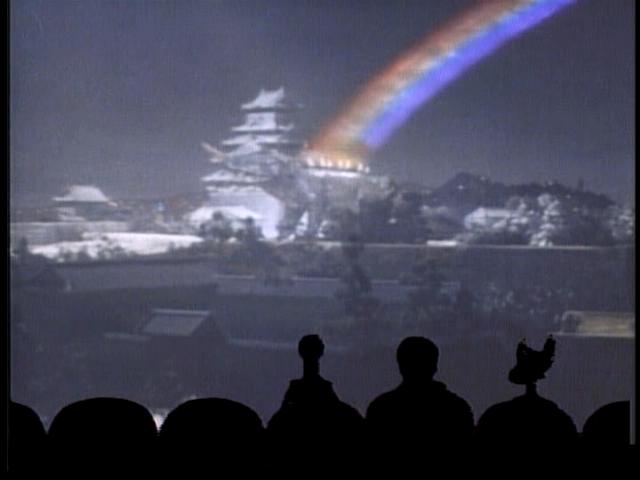
304: Gamera vs Barugon [Grade: C-]
Possibly the worst thing that could have happened to Showa era kaiju films was the shift to color. I’m not sure why it is, but bad special effects have a way of looking worse in color than in black and white. The flaws somehow pop out more readily.
While Gamera suffered from this as much as any of his other fellow hundred-foot hellbeasts, there were plenty of other ill-advised decisions that went into this film. Possibly the most flawed proposition was the idea to increase the prestige of the budding franchise by marketing the new film towards adults. As well as replacing the relatively green director of the first movie with a thirty plus year studio veteran, a storyline completely devoid of kids would be used. In this case, a WWII veteran had discovered a giant opal on a South Pacific island that he was forced to abandon when captured and sent to a POW camp. Now he’s setting up an expedition to retrieve it. Since his war injuries prevent him from coming along, he sends his younger brother in his stead along with two other sketchy types. When the opal is recovered, treachery sets in as one of the sketchy guys fails to warn the other sketchy guy about the poisonous scorpion crawling on him and uses explosives to seal the younger brother in the cave where they found the opal. Of course, it’s not really an opal but a monster egg that hatches upon arrival in Japan. What’s more, exposure to infrared radiation during its incubation causes it to grow at an unnaturally rapid rate.
For the most part, this is something designed to appeal more to yakuza film audiences. But what kaiju movie fans want is guys in rubber monster suits duking it out. This installment of the Gamera franchise easily has the briefest amount of fighting action, well under ten minutes worth. So, it wasn’t a big surprise that it flopped, and the studio suits recognized the error of their ways. But it wasn’t entirely devoid of kaiju goofiness, with Barugon possessing two rather silly-looking attacks. First is his tongue, with which he sprays an icing attack and can use as a ram. His rainbow death ray may be a case of cultural perceptions being at odds. I’m reminded of a line from the anime series Baccano which has led me to believe that they have a more pessimistic view of rainbows in Japan. Here is the full quote:
“From the time we are but children, we see rainbows as beautiful things. Without a doubt in our heads, upon sight, they are harmonious to our spirit. I’ve always wondered why that was. Of course, people who do not understand science or the refraction of light might see this anomaly in the sky as the harbinger of a natural disaster, thinking that something unwelcome might be coming down from that rainbow. Perhaps vegetation might be ablaze at the foot of the rainbow, bringing destruction. At any rate, we still see these seven-colored pieces of information with a sense of faerie tale magic to them.”
Really makes you think, don’t it?
The host segments are an odd lot this time around. From Midwestern soccer mom kaiju having lunch at T.G.I. Tokyo’s to Joel reminiscing about drive-ins and the 5000-piece fightin’ men & monster set, they provide enough chuckles to make up for what must be the dreariest of the Gamera films.
- Favorite riff: “Gamera loves flames.” But they go straight to his hips.
- Stinger: Kawajiri giggles with delight over discovering the “opal”.
- Alternate stinger: Agree.
- Bechdel Test: Pass. One of the female enlisted asks about the diamond and Karen replies to her question.

305: Stranded in Space [Grade: B+]
A pilot episode that never got picked up for a series. It’s really a shame, as I think it could have gone for three or four seasons. In the final host segment, Crow pitches it as The Fugitive meets Logan’s Run. I’d replace the Logan’s Run mention with 1984, but not as a lazy analogy regarding an oppressive government with ubiquitous surveillance. They share other elements which the average shmoe forgets were in 1984. First off, Ward E bears considerable likeness to Room 101. Then there’s the effective erasure of any history prior to the regime’s founding. This particularly gets hammered in during a scene where our protagonist Neil Stryker asks the elderly book shop proprietor why the “complete” history book only goes back thirty-five years. For a bit, he recollects on the old days and how there used to be concerts in the park and how people seemed to laugh more. Then he realizes how what he just said might be perceived and adds, “But things are much better now,” with an undertone of, “Please don’t call the men in white coats.”
Overall, it’s a decent production with only a few minor faults. One is the concept of an opposite orbit concealing the existence of a twin planet, since this could only work if Earth had a perfectly circular orbit (it does not). The fact that both developed the same life forms and topography, as well as everyone speaking English, really stretches credulity. The bit with the inhabitants of Terra all being left-handed can probably seem a bit silly. However, the production staff puts in some genuine effort to remain consistent on that point. There’s the occasional minor slip-up, but you have to be really looking for them to notice.
It’s this general competence that probably makes it difficult for Joel and the Bots to riff on it, with the only element they can latch on being that it’s an obvious 1970s television production (so plenty of cracks about Quincy and Rockford). The host segments are also a bit underwhelming, though the one where the Bots ponder on the nature of Ward E gets some chuckles.
- Favorite riff: “Funny how space looks a lot like Sacramento.”
- Stinger: Bettina wuss slaps Stryker.
- Alternate stinger: Agree.
- Bechdel Test: Fail. None of the female characters audibly converse.

306: Time of the Apes [Grade: C]
No matter what the medium, every work of fiction requires a certain amount of coincidence to kick things off. The trick is to not make it too obvious. On that front, Time of the Apes falls short. Mildly annoying brat Johnny (original name Jiro) visits the lab his uncle works at with his friend Caroline (original name Yurika). They’re given a tour by Catherine (original name Kazuko), who shows them their work on cryo-stasis using monkeys. Suddenly, an earthquake strikes and some falling debris hits the Plot Contrivance Switch, sealing Johnny, Caroline, and Catherine in cryo-stasis chambers. When they’re revived, they find themselves in a time where apes evolved from men.
At this point, things get rather muddled as we get bombarded with a series of frequently disconnected sequences. This is because Time of the Apes was originally a 26 episode television series meant to cash in on the massive popularity of Planet of the Apes in Japan. No matter how good the material is, trimming that amount of footage down to an 80-90 minute movie is going to result in an incoherent narrative. But even taking the extensive cuts and the shoddy dub (Caroline’s voice is especially painful) into account, there’s still plenty of evidence that it was at best a mediocre effort. But the real slap in the face occurs at the conclusion where we’re subjected to the hoary “it was all just a dream” cop-out ending.
Host segments are mostly winners, such as Servo’s narration concerning the snippet used for the stinger and Crow’s fashion show report on the foppish attire the apes wear. The one black mark is the reenactment of the Scopes Monkey Trial. It could have generated a few chuckles, but Joel’s leaden narration brings the whole thing down.
Favorite riff: I’ll bet Johnny cares now.
Stinger: “Johnny, don’t go. It’s too dangerous.” “I don’t care!”
Alternate stinger: Perfect!
Bechdel Test: Pass. There are multiple non-male conversations conducted between Catherine and Caroline.

307: Daddy-O (with Alphabet Antics) [Grade: D]
And now we reach the first of my virgin viewings. I must say, I was thoroughly underwhelmed and am confounded regarding this episode’s popularity. First there’s the short, which was aimed at the Sesame Street demographic and left me cold. As for the main feature, it’s a crime drama, so automatically gets off on the wrong foot. The main plot concerns a trucker/singer (an obvious knockoff of Elvis Presley) who investigates the death of a friend who somehow got roped into a drug smuggling racket. But just as prominent is his relationship with a sassy, busty platinum blonde with whom he shares an initial mutual loathing that clearly must mean Love. Much Ado About Nothing has so many crimes to answer for.
The host segments are largely duds. The only memorable bit involved Dr. Forrester’s invention of a pacifier shaped like a facehugger. While “Hike Up Your Pants” is not as bad a song as “Clown in the Sky”, that’s a rather low bar to clear. Their parody of the drag race scene fails on account of them not doing anything that interesting with it. Then there’s the conclusion where the button used to go to the end credits malfunctions. The credit roll stops a few seconds in to go back to Deep 13 and gets repeated ad nauseum. In a way, it recalls the Cheese Shop Sketch from Monty Python’s Flying Circus. This should not be considered an endorsement, because I HATE the Cheese Shop Sketch. It’s drawn-out, wears out its welcome almost immediately, is not as clever as it thinks it is, and is lacking in any comedic value. It’s also the basis of the absolute worst card in the Monty Python Fluxx deck. It did my heart good when John Cleese indicated in an interview that he doesn’t really care for it either.
The final insult comes from the choice of stinger. You’d think that the “Want some?” bit would be a perfect choice. It’s prominently alluded to in the final host segment as well as the introductory bumper for this episode in the first ever Turkey Day Marathon. Instead they chose the nearsighted gym manager prohibiting Phil from entering the locker room. Alas, this won’t be the final baffling stinger choice. All in all, not a good time.
Favorite riff: “Your singing can’t be any worse than your driving.” You haven’t heard my singing yet.
Stinger: “Couldn’t help you if I wanted to, fella. Gym policy.”
Alternate stinger: “Want some?” *slap*
Bechdel Test: Fail. The conversations between Jana and Peg are about Phil.

308: Gamera vs Gaos [Grade: C+]
There’s an observation of sorts concerning how Japanese women often look like teenagers until some point in late middle age, when they morph into Yoda-like beings. This came to mind when I came to the realization that the woman I had presumed was Eiichi’s mom is actually his sister (the actress in question was 21 at the time).
And who is Eiichi? He’s the requisite bratty half-pint that is always included in the Showa era Gamera films. His physical resemblance to Kenny/Toshio from the first installment is so strong, I had to check at IMDB to be sure that it was a different kid. Speaking of IMDB, that’s where I obtained the spelling of his name. For you see, the pronunciation has the misfortune of being near identical to itchy (which is how several MST3K blogs and web sites spell it).
Anyway, Gamera’s opponent this time around is Gaos, a sort of giant bat thing with a wedge-shaped head that shoots sonic rays from its mouth. Allegedly it’s supposed to be a kaiju version of Dracula on account of the bat motif and a vulnerability to sunlight. It appears that it had been slumbering until volcanic activity woke it up and is now going about causing widespread destruction as kaiju are wont to do.
There’s also a subplot concerning a road construction crew at odds with some farmers unwilling to sell their land. But we the audience don’t particularly care, as we came for the kaiju fights. While not as bad as the previous installment, there’s still too much focus on the bland human story and the heel kaiju rampage and not enough of the kaiju duking it out. The battles are considerably gorier than in previous installments, with oddly colored fluids squirting out whenever a wound is inflicted. Some might regard this as a bit much for a property aimed at kids. But consider Detective Conan, a long running series also aimed at children which regularly features gruesome murders. They just have some very different standards for what’s acceptable for the kiddies in Japan.
On the host segment front, the top performer is easily the one where Servo and Crow keep interrupting Joel’s Gaos head crafts project by encouraging kids to do stupid things like eat mucilage and deface library books. Though their cut short production of Gamera-dämmerung is a worthwhile effort thanks to some impressive props.
- Favorite riff: Munchy, crunchy, chocolatey commuters.
- Stinger: Comic relief guys get scared.
- Alternate stinger: Gaos gets a rock.
- Bechdel Test: Pass. Eiichi’s sister and the old woman talk about the road construction.
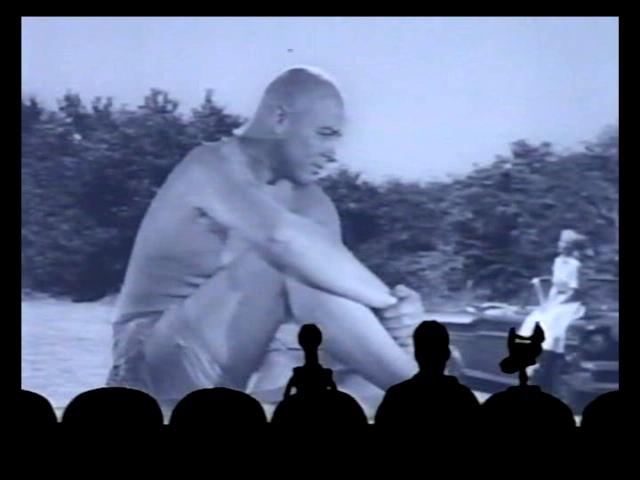
309: The Amazing Colossal Man [Grade: B]
I suppose it could be coincidence, but it seems quite stretch to believe that Bert I. Gordon’s focus on size abnormalities in his movies wasn’t at least partially on account of his initials. Much like Robot Monster, this film’s notoriety is in part thanks to regularly being screened by horror hosts across the nation. No surprise on that score, as it has all the traits you expect to see in a 1950s B feature. The abnormal growth of Glenn Manning is courtesy of nuclear radiation, but the pseudo-science doesn’t stop there. Apparently, his heart is growing at a slower rate, which gets explained as being due to the heart being a single cell. I’m not sure if Mr. Gordon misinterpreted some obscure scientific fact or he just pulled it out of his hinder, but Joel and the Bots subject it to considerable derision.
It could be due to either a mediocre acting performance or my own low tolerance for angst, but Manning’s constant bemoaning of his fate makes him come across as a mopey whiner. Eventually he completely loses it, going on a King Kong style rampage in Las Vegas before eventually taking a fatal tumble off the Hoover Dam. Or is it?
The host segments are reasonably strong this time around. The best involves Joel and the Bots thinking of more tactful ways to deliver the bad news of Manning’s prognosis to his fiancée compared to the rather blunt statements provided by the doctor. Naturally, the ones Servo and Crow come up with are even more insensitive.
Favorite riff: Susie thinks she doesn’t need a seatbelt. Watch Susie go ballistic through the windshield.
Stinger: Glenn laughs until it hurts.
Alternate stinger: Agree.
Bechdel Test: Fail. The conversation between Carol and the hospital receptionist is about Glenn.

310: Fugitive Alien [Grade: B-]
With the success of Star Wars, studio executives were on the lookout for material to meet the demand for science fiction that was more upbeat than the past decade’s pessimism. In Japan, Edmond Hamilton’s Star Wolves novels were very loosely adapted into a television series. Lead character Ken was broadly modeled on Morgan Chane (the protagonist in the books). His background as the son of human missionaries on the Star Wolf homeworld who would join them in their raiding activities until he killed a fellow Star Wolf and went AWOL remained intact. However, some of his more morally ambiguous traits were altered. The most notable being that the killing of a fellow Star Wolf was prompted not over him balking over an order to kill a child (as in the TV series), but over a disagreement concerning shares in plunder (which occurred in the first book).
Like Time of the Apes, the movie is a series of loosely connected television episodes. One difference is that Fugitive Alien spackles them together with bits of narration, resulting in a more coherent narrative. It’s still a mess, but there are hints that the source material may be worth tracking down.
Host segments are largely underwhelming this time around. Joel forcing the Bots to reenact random scenes is particularly lazy, as he merely recites lines from the movie rather than twist them in a creative fashion. One plus is that this is the first time that Mike does his portrayal of Jack Perkins, along with the abuse Dr. Forrester and Frank subject him to. Reportedly, the real Jack Perkins was a good sport over it, which is nice to know.
- Favorite riff: “I don’t want to die in the middle of nowhere.” I want to die in the thong section of Victoria’s Secret.
- Stinger: “Hahahahahahahaha! You’re stuck here!”
- Alternate stinger: Perfect!
- Bechdel Test: Fail. None of the female characters interact.

311: It Conquered the World (with Snow Thrills) [Grade: A]
The short looks to be an old newsreel of a winter sports festival that must have had a very active first aid tent. In particular, many of the ski jumpers look like they’re trying to outdo Vinko Bogataj. Also, the narrator insists that skiing is pronounced she-ing (something to which Joel expresses great skepticism).
As for the feature, it was the first of many films directed and/or produced by Roger Corman that were screened. The Brains have regarded Corman with varying degrees of hostility. I honestly don’t think it’s deserved. Now granted my judgment may be affected by the fact that the first Corman film I ever saw was The Fall of the House of Usher. The Poe films are probably his best material and gave me a good first impression. I’ll be the first to acknowledge that he’s not an artist (at least in the way the term is commonly defined) and that he’s done his share of bad films. However, his overall average is much better than many of the other would-be auteurs who get featured on MST3K.
It Conquered the World is another of those movies that has had its share of horror host screenings, with its fake-looking alien being particularly memorable. As was common in 1950s alien invasion movies, the conquest is done through subterfuge rather than military force. While some proclaim that this reflects on the Red Scare paranoia of the era, the real issue was budgetary considerations. Just as classic Doctor Who was restricted to 4-6 Daleks or Cybermen on the set at once, B movie units simply didn’t have access to the financial resources available to the likes of George Pal.
The story involves a bitter scientist with a reputation as a crackpot who believes that he’s in radio contact with aliens from Venus, who he claims have hijacked an Earth satellite. While he insists that their intentions towards humanity are benevolent, their use of mind alteration make the statement ring hollow. Much like Stranded in Space, the movie is quite engaging, with the unfortunate side effect of tepid riffing, especially compared to how they were firing on all cylinders with Snow Thrills.
Host segments are an improvement from the last episode, this time doing parody correctly. Their parody of Snow Thrills is somehow even more insane than the actual short, while their take on the dinner party scene from the movie involves considerable petty sniping in the vein of Who’s Afraid of Virginia Woolf?
- Favorite riff: He holds the world’s fate in his hands, and he can’t drive a stick.
- Stinger: “He learned too late that a man is a feeling creature…”
- Alternate stinger: Paul pokes the mind control bat with extreme prejudice.
- Bechdel Test: Pass. Claire and Joan talk about the cake.

312: Gamera vs Guiron [Grade: A]
The Gamera franchise has finally gone all-in with the children’s entertainment niche. Though technically it started with the prior film in the series Gamera vs Viras. Speaking of which, I would personally recommend checking out this fan project called MST3K vs Gamera Round 2, which riffs the Showa era Gamera films the original MST3K never screened. There’s also a memorable host segment that pays tribute to the Doctor Who serial “Genesis of the Daleks”. Just type the name into the YouTube search engine and enjoy.
But back to Guiron. This new focus proves to be a mixed blessing. On one hand, the kaiju battles gain greater prominence and their staging and tactics become more creative. On the negative side, plot logic is thrown to the wayside. Even if it’s not really the case, there’s the sense that the scripts have gone from being written for children to being written by children, with elements like the protagonist going off with his best friend on a grand adventure while ditching his annoying sister in the process. This is particularly apparent in the design of the heel kaiju Guiron. As well as a head shaped like a blade that performs in the manner of one of those infomercial knives, it also shoots out giant ninja throwing stars. Just try to convince me that wasn’t conceived by someone with a single digit age.
A host of other oddities abound. The most noticeable is the English dub. While the dubbing in the prior installments haven’t exactly been quality work, this one descends to a completely new level of incompetence. As well as the awkward grammatical structure, characters often pepper their speech with unnatural pauses. Another aspect that ended up driving Servo crazy was the sloppy translation of hoshi. Hoshi can be used to refer to a star or a planet, in the sense that they’re both lights in the night sky. However, the translators were lazy and always wrote it up as star even when the context made it obvious that it was meant to be planet. Tragically this specific translation snafu still happens. The most recent instance that comes to mind occurs in the 2014 science fantasy anime series Nobunaga the Fool, which involved one of those concepts (in this case, Oda Nobunaga teaming up with Joan of Arc and Leonardo da Vinci) that looks awesome on paper but falls flat in execution.
Finally, there’s Cornjob, who has the appearance of an Asiatic Milhouse Van Houten and the personality of a slightly less uptight Barney Fife. Of course, that’s not his real name. Joel and the Bots merely misheard him being called Kon-chan. Chan is one of those honorific suffixes, in this case a highly informal one typically used when addressing a best friend or a younger relative (in essence being that pet name you wish your mom wouldn’t use in front of your friends). Needless to say, a child addressing a police officer in such a fashion would be considered quite impertinent.
But to truly comprehend the insanity, you must see it for yourselves. Fortunately, Joel and the Bots are in top form with their riffing. Host segments are also excellent, with the most memorable being the Richard Burton pageant, on account of the Caucasian kid bearing a vague resemblance to him.
- Favorite riff: Crow: You know, this is just like Hamlet. Everybody dies. Tom: There are many parallels to… What are you talking about?
- Stinger: “What a monster.”
- Alternate Stinger: Cornjob disapproves.
- Bechdel Test: Pass. Barbella and Florbella have multiple non-male conversations.

313: Earth vs the Spider (with Speech: Using Your Voice) [Grade: B+]
The short is pretty much what it says in the title. It helps that the narrator avoids the authoritarian pomposity often encountered in the instructional shorts of this era. Though whoever wrote the script doesn’t appear to have thought through the phrasing of the advice to use plenty of lip and tongue action.
The main feature is a Bert I. Gordon Giant Rampaging Critter film which originally had the title The Spider. The alternate title used in this print is quite misleading, as it implies either a threat that is extraterrestrial in origin or at least international in its scope. Instead, it comes from a nearby cave and menaces a small southwestern town. Elements of the teen angst films of the 1950s are injected in a similar vein as The Blob. Also like The Blob, several of these “teens” are clearly in their twenties or even thirties. But then it’s easier than trying to comply with Coogan laws. A key difference from The Blob is that the two high schooler leads, rather than being key to defeating the monster, are a danger to themselves and others as they cause the complication that must be dealt with in the third act. It’s pretty clear that, compared to teen exploitation flicks from someone like Roger Corman, Mr. Gordon does not have a high opinion of Kids These Days. As is typical with a Bert I. Gordon film, the special effects are erratic, with the spider frequently changing its size and sometimes coloration.
On the host segment front, we see the origin of two of Crow’s recurring shticks. The first is his ambitions as a screenwriter with the introduction of Earth vs Soup. Then there’s how, whenever the Bots are assigned to do a school report involving the feature, Crow’s effort will involve a bit of halfhearted research mixed with a bunch of made-up details. Even people who aren’t uptight, pretentious film snobs can regard his thesis on the parallels between the filmographies of Bert I. Gordon and Orson Welles as fundamentally flawed.
- Favorite riff: So maybe your dad just parked the truck down there and, like, vandal squirrels came and ripped the doors off and broke the windshield and stuff.
- Stinger: Drunken mumbler mumbles drunkenly.
- Alternate Stinger: Agree
- Bechdel Test: Pass. Near the end, Carol and her mom exchange cries of relief when they reunite.

314: Mighty Jack [Grade: C-]
At a casual glance, one might assume that Mighty Jack is what The Man from U.N.C.L.E. would be like if it had been conceived by Gerry and Sylvia Anderson. It’s actually a thirteen episode Japanese television series compressed into an 80-90 minute movie by our old pal Sandy Frank, the man responsible for importing all the Japanese material screened in the third season. As you can imagine, the proceedings are an incoherent mess. Even more so than Time of the Apes if you can believe it.
But what is purely the fault of the original staff writers is the soporific dullness. The characters just yammer on and on and on and on. Really, a movie featuring a flying submersible should not be this boring. The real shame is that it’s alleged to have been followed up with a loosely related series called Fight Mighty Jack which is reported to be absolutely bonkers. Instead of blah spycraft, they go and battle kaiju like the Loch Ness Monster and what sounds like a cross between King Kong and a cyclops. That at least could provide some entertainment value.
Of course, there’s also the question of why they came up with a stupid title like Mighty Jack. In the context of the movie/TV series, it appears to be the name of the above-mentioned flying submersible. As for why, there appears to a naming practice for titles in Japan where two English words are selected at random and slapped together without regard for suitability or coherence. Thus, we get titles such as (and like Dave Barry, I swear I’m not making any of these up) Pumpkin Scissors, Kiddy Grade, Bubblegum Crisis, Zombie Loan, and Strawberry Eggs. Speaking of Dave Barry, these would also make great band names.
Host segments are reasonably good. The parody of the ridiculous interrogation scene from the movie provided many of the strongest laughs (though I don’t think keeping your eyes closed under such conditions would be as easy as Joel implies). The shanty “Slow the Plot Down” also serves as a nice mental palate cleanser.
Favorite riff: “You see, Fritz is my son.” You named your son Fritz?
Stinger: Fritz is loving his work.
Alternate Stinger: Perfect!
Bechdel Test: Fail. None of the female characters converse with one another.

315: Teenage Cave Man (with Aquatic Wizards and Catching Trouble) [Grade: D]
Though we get two shorts, I found neither to be all that remarkable, certainly not in the same league as X Marks the Spot, What About Juvenile Delinquency?, or Cheating. Aquatic Wizards features water skiing demonstrations while Catching Trouble has trapper Ross Allen bagging various Everglades fauna for a zoo. Though I imagine a lot of fans would disagree with my assessment of the latter. Allen’s capture tactics and general rough handling of the critters inspired considerable rage among both the Brains and the fanbase. The Our Gang style soundtrack probably didn’t help either.
As for the main feature, it should be noted that Roger Corman hated the final title, which was applied at the last second. I’ll agree that it’s quite ghastly, though his original choice Prehistoric World wasn’t much better. But it turns that the title change was fitting because, despite all the prehistoric trappings, this is ultimately a Teen Angst movie with all the tiresome baggage that entails. It certainly doesn’t help that Robert Vaughn (of The Man from U.N.C.L.E. fame) doesn’t make for a very credible teenager. Also, I’m not convinced that bow he slapped together would be effective. The reveal at the end that the members of this supposed prehistoric tribe are descendants of nuclear war survivors who were bombed back to the Stone Age makes things worse, as the script takes a preachy turn in the epilogue. This is not one of Corman’s finer moments. I imagine my opinion of his work would be lower if this had been my initial viewing of his filmography instead of The Fall of the House of Usher.
Host segments are mostly a loss. The Catching Ross sketch and its take that tone remind me why I consider bile and rage to be faulty instigators for comedy (though many fans seem to find it cathartic). The one saving note is the fight between Dr. Forrester and Frank, complete with Star Trek fight music.
- Favorite riff: “One of the clan has come to manhood.” At the tender age of 37.
- Stinger: The title character runs into a tree.
- Alternate Stinger: Agree
- Bechdel Test: Fail. None of the female characters converse with one another.
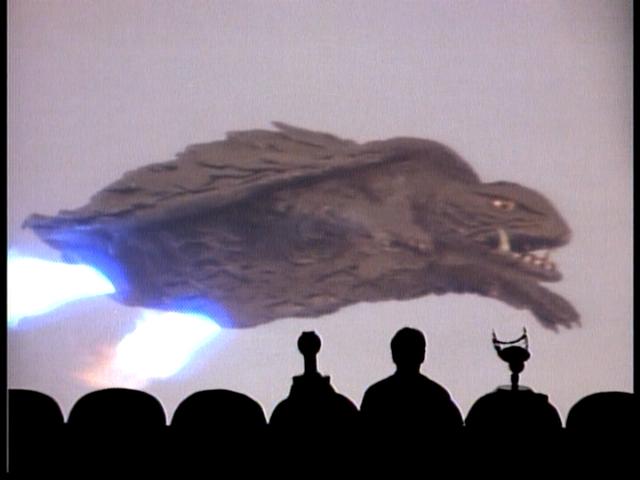
316: Gamera vs Zigra [Grade: C-]
Oh Gamera, how you have fallen. It’s bad enough you associate here with a couple of snot-nosed brats that are near equal to Kenny in their ability to be annoying (oddly enough, one of them is named Kenny). But they also have the survival instincts of Juanito from The Black Scorpion. I know you’re a Friend of All Children but having standards doesn’t hurt.
The heel kaiju this time around is a giant beaked fish thing from outer space or something. Apparently, his homeworld from four hundred light years away was destroyed. Somehow, it was because of humanity’s ecological carelessness. Yeah, I don’t follow that line of reasoning either. Now this all could be the result of the translators performing their job with indifference. Lord knows it wouldn’t be the first time. Still, there are plenty of signs that the Gamera franchise is in an advanced state of decay. One particularly bizarre sequence involves a hotel manager and a Sea World flunky arguing over who gets to purchase a meager catch of fish. It’s pointless and inane, yet the movie seems to expect us to care. It’s not surprising that the production studio went bankrupt shortly thereafter.
The host segments center around how this is the last Gamera film Joel and the Bots must watch. The Gamera model and the dioramas are kind of pedestrian, while the visit by the kids from the movie (with Bridget Jones making her first onscreen appearance) is just odd. The true highlight is when they each perform the Gamera Song in a different style. This includes reggae (Joel), beatnik free verse (Servo), gangsta rap (Crow), and Wagnerian opera (Gypsy), before finishing off with a barbershop quartet performance.
Favorite riff: Fish Argument Theater will be back. But first, a scene from Plot Convenience Playhouse.
Stinger: Sea World flunky talks to himself.
Alternate Stinger: Agree
Bechdel Test: Pass. The beachgoers discuss the evacuation order.
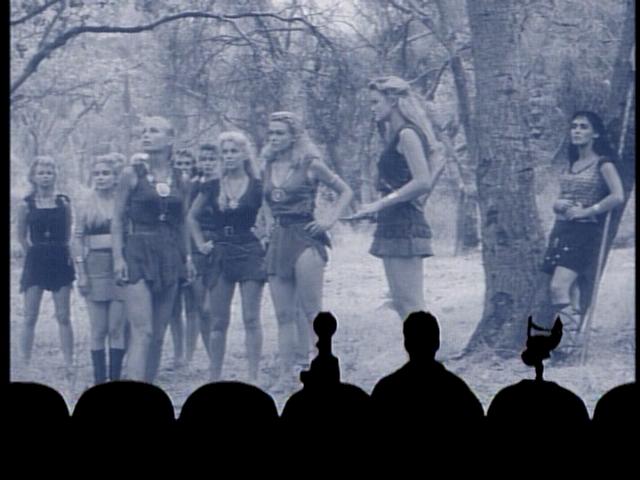
317: The Saga of the Viking Women and Their Voyage to the Waters of the Great Sea Serpent (with The Home Economics Story) [Grade: B]
Quite a mouthful, isn’t it? But since this is an early Corman film, that means there’s plenty of room for a short first. While the narrator states that this one is for the girls to watch, it thankfully isn’t Molly Grows Up. Instead the girls thinking of going to college are encouraged to consider a Home Economics major. In our Oh So Enlightened Times, it’s easy to dismiss it as brazen conditioning for a life of household drudgery. Perhaps. Though it can also be argued that the HE courses have more practical applications than some of the college majors that have cropped up since this was released in 1951.
The main feature concerns a Viking tribe whose menfolk went on an expedition three years ago and still aren’t back. Technically there’s still one guy named Ottar who was left behind. It’s not all that clear whether he’s 4-F or was too young to go along or something else. Anyway, the miniskirt-sporting Vikings ladies (I’m not really sold on the authenticity of those costumes) resolve to find out what became of them. Eventually they run afoul of the above-mentioned sea serpent, rendered as a glorified sock puppet that immensely pales in comparison to the image on the movie poster. According to Corman’s autobiography, it was the result of a new special effects team that talked big but were unable to deliver and the result is something he’s not terribly proud of.
Anyway, they wash ashore in the territory of the Grimaults, who might be Slavs or Mongols or something. It’s hard to be sure. Of particular note is the ruler’s whiny effeminate heir. You get the sense that his social status is the only thing standing between him and a series of wedgies and pantsings and other such demeaning treatments that jocks traditionally inflict on unathletic nerds. In an acceptable level of coincidence, the Viking men also washed ashore previously and are now slaving away in the Grimault mines. Eventually they manage to escape and the pursuing Grimaults themselves fall victim to the sea serpent, allowing them to go home to breed a new generation of Vikings.
As Corman films go, it’s fairly middle of the road. Though not as tiresome as Teenage Cave Man, it’s also less engaging than It Conquered the World. This is also an uncommon instance for the Joel era where the host segments have nothing to do with the feature or the short. At least I don’t recall any mention of waffles. In non-waffle matters, Dr. Forrester’s meat reanimator is equal parts hilarious and disturbing.
- Favorite riff: So, the Vikings gave us the underwire bra?
- Stinger: “But you don’t understand! I’m a prince!”
- Alternate Stinger: Agree
- Bechdel Test: Pass. Though the Viking women frequently talk about their absent menfolk, they converse on many other non-male topics.

318: Star Force: Fugitive Alien II [Grade: [Grade: B-]
Pretty much picking up from where the first Fugitive Alien “movie” left off, Ken and the crew of the Bacchus 3 set out to sabotage a superweapon in possession of a hostile power that could destroy the universe. As superweapons go, that seems a bit excessive. The storyline concludes with about fifteen minutes of runtime left, so we switch rather abruptly to a final confrontation with the evil leader of the Star Wolves. Probably the most accurate description of his appearance is Darth Vader as a mime.
Going off on a tangent, I had noted previously how the Star Wolf television series was intended to cash in on the popularity of Star Wars. But here it gets especially brazen. An attack on the Bacchus 3 as it approaches the planet holding the superweapon bears a strong visual resemblance to the dogfight that occurs as the Millennium Falcon escapes the Death Star. Such cribbing can also be seen in Ken’s climatic battle with Darth Marceau, which looks rather like the trench dogfight. Speaking of Ken, he constantly has this goofy smile on his face as he slaughters hordes of unsuspecting mooks. It really is quite disturbing.
As with the prior Fugitive Alien episode, host segments are unmemorable. The one big exception is the commercial for the Captain Joe (the boozy commander of the Bacchus 3) Action Figure, which includes an intervention by Barbie, Ken, and Donatello.
- Favorite riff: “Where are Ken and Dan?” That’s a good question. Let’s talk about it on the way home.
- Stinger: “Captain, I’ve got it fixed! It’s all working again!”
- Alternate Stinger: Agree
- Bechdel Test: Fail. None of the female characters converse with one another, with Tammy the only female character through most of the film.

319: War of the Colossal Beast (with Mr. B Natural) [Grade: C+]
There are some episodes where the short outshines the feature, and this is probably the first indisputable case. Mr. B Natural is essentially a commercial for Conn musical instruments aimed at the parents of kids thinking of joining the school band. But to make that less obvious, they wrap around a story featuring the shrill and peculiar hellbeast known as Mr. B Natural and nebbish junior high loser Buzz Turner. The most noteworthy moments occur during the scene where Mr. B teleports into Buzz’s room and convinces him that joining the school band would be swell. Much of their conversation has the unfortunate side effect of giving Mr. B a pedophile vibe. It’s no surprise that Joel and the Bots zero in on it with their riffing. Another thing they focus on is how the natural reaction to an androgynous manifestation of a musical note dressed in a blueish Peter Pan costume is more likely to be terror than bemusement. The eventual switch from brightly colored insanity of the short to the black-and-white dreariness of the main feature is something of a letdown.
Before Pirates of the Caribbean and Back to the Future, War of the Colossal Beast attempted to make a sequel of a film that really isn’t designed for one. After all, Glenn Manning took a rather fatal tumble off the Hoover Dam. They try to cover for this with the spurious claim that the Colorado River is up to a mile deep in spots (it’s not). Anyway, Glenn has lost all ability to reason and is now haphazardly rampaging. On the plus side, this means we’re no longer subjected to his morose whining. Unfortunately, someone got the bright idea that Glenn should have had one of his eyes gouged out. The resulting makeup job is not a pleasant sight.
One scene that sticks in the mind involves a junior high field trip at the Griffith Park Observatory shortly before Glenn menaces it. As junior high students are wont to do in these situations, two of them have snuck off for some alone time. What stands out is how the boy has yet to experience puberty, while his female companion has quite clearly already done so, making for a rather odd couple to say the least.
The host segment where Servo and Crow argue over whether Mr. B Natural is a man or woman is likely to receive a different reaction nowadays, and I’ll just leave it at that. Less controversial is Joel mimicking the news anchor from the movie, making bizarre and increasingly nonsensical predictions in the manner of Criswell.
- Favorite riff: Mr. B, what would you know about dignity?
- Stinger: Mr. B prances like a ninny.
- Alternate Stinger: Agree
- Bechdel Test: Pass. The field trip chaperone asks the busty junior high student where she’s been and is offered a lame excuse.
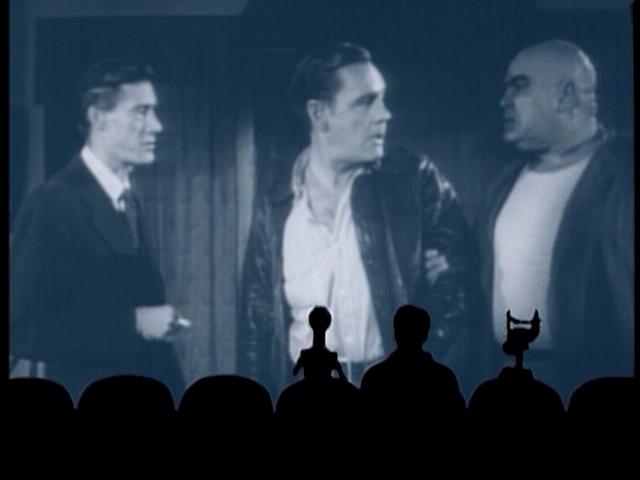
320: The Unearthly (with Posture Pals and Appreciating Our Parents) [Grade: B-]
Another double dose of shorts, with both aimed at the elementary school set. Posture Pals involves a classroom competition on posture improvement and metaphors about trees and slumping clown dolls. Appreciating Our Parents concerns clueless little punk Tommy, who apparently believes that the household chores are done by brownies or something. Neither short particularly stands out on its own, though the latter one serves as the inspiration for what is the most gut-busting host segment of the episode.
The feature is set in a psychiatric rest home run by mad scientist Dr. Conway, who uses the patients as guinea pigs for his immortality experiments. An opportunity presents itself when the obligatory hulking assistant catches escaped death row convict Mark Houston skulking about the grounds. He would make an excellent test subject, since he wouldn’t be missed if things went wrong. Again.
One of the more curious aspects is how the characterization of the protagonist and antagonist skew from the usual template. The traditional mad scientist is a pariah dismissed by more conventional scientists for the outlandish theories he espouses. Conway keeps mum about his project and doesn’t intend to go public until he gets results, thus maintaining his professional credibility. In Mark’s case, he’s a rare instance of an MST3K protagonist who is competent. All too often the so-called heroes in these films are either ineffectual chumps who blunder their way through the narrative or hotheaded nitwits who charge into situations half-cocked. Mark actually thinks through his actions and doesn’t let his pride get in the way of calling in reinforcements when the situation warrants it. So it’s quite unfortunate that these characters are wasted on such a dull and plodding movie.
The host segments are largely quite odd, though in a good way. The standout is the parody of the Appreciating Our Parents short, which really emphasizes the subtext that Tommy is kind of an idiot. Dr. Forrester’s invention of the Hard Pills to Swallow is easily one of the most malicious things he ever came up with.
- Favorite riff: Not the #23 scalpel! You’re mad, Doctor!
- Stinger: “Time to go to bed.”
- Alternate Stinger: Agree.
- Bechdel Test: Pass. Sharon and Grace talk about the latter settling in.

321: Santa Claus Conquers the Martians [Grade: A]
Of all the holidays, Christmas reigns supreme in its presence in American media. It’s true that Halloween and Thanksgiving have marked their own territory, and the Peanuts franchise once did an Arbor Day special. But Christmas remains preeminent, for good and for ill (unfortunately, ill seems to have a majority that is strong though not overwhelming). So, it was inevitable that MST3K would have its own Christmas episode.
As a movie choice, Santa Claus Conquers the Martians has considerable stature of sorts, being something of a children’s Christmas movie equivalent of Robot Monster. One the most interesting casting choices in retrospect was Pia Zadora as one of the Martian children. As an adult, she garnered notoriety when she received a controversial Best New Star Golden Globe for her role in the critical bomb Butterfly (which gets alluded to in the riffing).
Despite its science fiction trappings which help it stand out in the mix, it’s a typical mediocre children’s entertainment with grating kids, half-witted adults, and a Santa Claus whose pipe (judging from his behavior) has something other than tobacco in it. But what really brings in the pain is Dropo. Dropo is one of those horrible unfunny comic relief characters that the kids seem to love but the typical adult instinctively despises. You can only wonder what Hell awaits Mars when Santa appoints him as the Santa of the Red Planet. The actor Bill McCutcheon would continue in children’s entertainment, including a stretch on Sesame Street as Uncle Wally.
The Christmas-themed host segments are mostly winners. The Wish Squisher, which turns gifts kids want into boring stuff like socks and underwear, is the sort of spiteful concept you’d expect from Deep 13. And if that isn’t traumatizing enough, the new products from the Island of Misfit Toys like Mr. Mashed Potato Head ought to do the trick. “Let’s Have a Patrick Swayze Christmas” is easily the best song of the third season. And the ultimate refutation of the cynical Christmas essays was a nice touch.
- Favorite riff: I want those kids dead! I want Santa’s house burned to the ground!
- Stinger: Voldar laughs derisively.
- Alternate Stinger: Agree.
- Bechdel Test: Pass. Betty exchanges goodbyes with Momar and Girmar.

322: Master Ninja I [Grade: B]
Back in the days before DVD collections, the only chance to watch episodes of a favorite series after summer reruns was if it got syndicated. But since off-network syndication requires at least sixty-five episodes of material, one season wonders were out in the cold. The best they could hope for (at least the dramas) was to have two episodes slapped together as a “movie”, much like what Sandy Frank did with Fugitive Alien and Mighty Jack. Such was the fate of The Master, a 1984 television series featuring washed-up spaghetti western actor Lee Van Cleef as a WWII veteran who settled in Japan where he learned ninja secrets and Timothy Van Patten (while the riffing frequently refers to him as Dick Van Patten’s son, they’re half-brothers) as his mush mouth protégé.
In essence, it’s The A-Team with ninjas and some elements of Route 66. But if you think The A-Team is bad (and a considerable portion of the plots that series fielded were as poor as the title characters’ marksmanship), it has nothing on The Master. The first half of the “movie” involves an evil businessman trying to claim a small airfield whose owner refuses to sell by any means necessary, so he can build a shopping center in its place. Then the second half awkwardly transitions to a San Francisco night club being harassed by a Tong syndicate for not paying protection. The first half is notable for some recognizable guest actors. First and foremost is that the requisite damsel is none other than Demi Moore, in her pre-Brat Pack days. Then there’s the crooked sheriff portrayed by Bill McKinney. If you don’t recognize the name, you’ll at least know of his minor yet unforgettable role in Deliverance, which is practically the only thing many people recall about that movie. You know, “Squeal like a pig!” The second half is more tiresome, mostly due to the actor portraying the Tong boss. He regularly employs these Shatner-esque pauses which are intended to make him sound menacing, but instead have him come across as self-important. Looking at this mess, it’s a good thing Timothy Van Patten switched from acting to directing, where he has enjoyed considerable success.
Host segments are a rather bland lot this time around. Promising ideas like the character theme music and the nunchuk variants go nowhere and ultimately fizzle out. The only memorable one is Crow’s convoluted conspiracy theory of Dick Van Patten’s iron grip on B-grade television.
- Favorite riff: You know, I’ve got the money, the club, and the girl. Yet I feel empty. Why?
- Stinger: “To them it’s some kind of ritual.”
- Alternate Stinger: The sheriff gets roped in.
- Bechdel Test: Fail. Demi Moore portrays the only female character with a speaking part in the first half, and none of the female characters in the second half interact with each other.
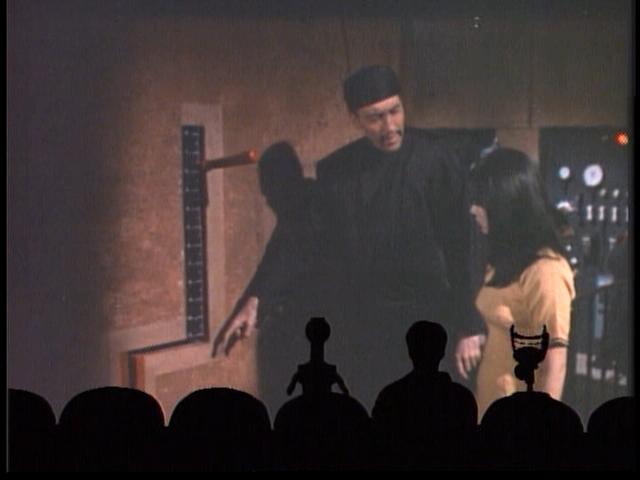
323: The Castle of Fu Manchu [Grade: D]
Several years ago, I downloaded a copy of The Insidious Dr. Fu-Manchu from Project Gutenberg to see what the big deal was. Once you get past the overt racial stereotypes, it was an okay read. It provided enough grounding to see that The Castle of Fu Manchu took some liberties with the source material. Right off the bat, we see him deal with an insubordinate minion by shooting him with a pistol. One of the character’s defining traits is his contempt for firearms, with neither he nor his henchmen using them. Then there’s the matter of Nayland Smith’s sidekick Dr. Petrie. It appears that the Rathbone Sherlock Holmes movies were used as inspiration, since the good doctor is a dithering buffoon. His voiceover even sounds like Nigel Bruce.
Oh yes. Likely due to being a British/Italian/West German co-production shot mostly in Barcelona, everyone is dubbed over. This is particularly egregious with Fu Manchu being portrayed by Christopher Lee. He’s already unrecognizable under all that makeup. If he doesn’t get to use his own distinctive voice, there isn’t much point in casting him. They may as well have had John Bennett in the role for all it mattered.
As for the plot, it’s kind of a mess. Apparently, Fu Manchu has created some sort of gadget that can freeze vast swathes of the ocean and he plans to use it to bring desolation to mankind. This begs the question as to why. At his core, Fu Manchu is an Asiatic Moriarty. Committing widespread destruction for its own sake doesn’t really fit the archetype. I suppose it could have been a part of a ransom scheme, but it isn’t presented very clearly.
Speaking of lack of clarity, there are several instances where scenes are shot in what could be called Cataractvision, with the picture consisting of indistinct blobs. It’s done in such a way that I suspect was intentional rather than a result of faulty equipment. But again, there’s the question of why.
Having Joel and the Bots being reduced to blubbering wrecks by the experience is a bit over the top. But this is one of the more plausible movies where such a thing could happen. The one fault occurs at the end when the Mads are celebrating their victory and Joel delivers a “You Haven’t Beaten Us” monologue which is intensely corny. Unfortunately, it’s a bad retch-inducing kind of corny. I seem to be in the minority with this opinion, as fan reaction appears to be largely positive. What can I say? I just go by what I like and dislike, regardless of popular opinion. At least the bit where the Mads are challenged to riff the film and they find themselves stymied makes for a good denouement.
As a final note, some of you may recall that my fellow Mutant Deneb had written a review of the first installment of this particular series of Fu Manchu movies and found it enjoyable. However, Castle is the sort of finale you get with a franchise that has worn out its welcome.
- Favorite riff: Here, I have everything you’ll need. I threw in the hairy naked man just for kicks.
- Stinger: Monkey pile on the castle guard.
- Alternate Stinger: Agree.
- Bechdel Test: Pass. Lin Tang and Lisa exchange code phrases.
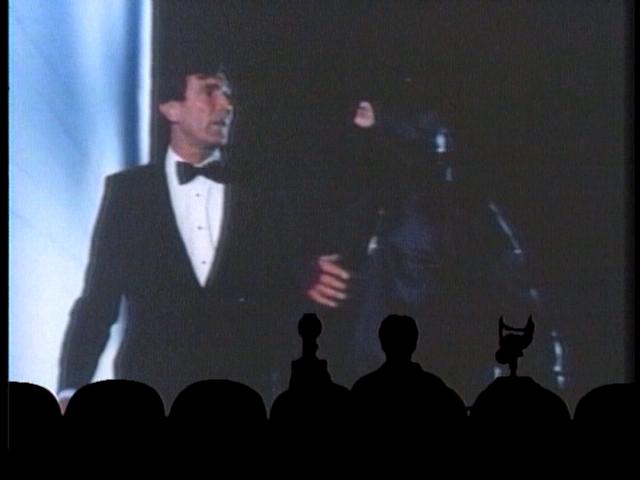
324: Master Ninja II [Grade: B]
More A-Team-esque ninja hijinks starring Lee Van Cleef and Timothy Van Patten in two unconnected TV episodes masquerading as a movie. The first half involves them riding into a town where the workers at the local cannery are trying to form a union. While antagonists in 1980s action shows weren’t known for in-depth characterization, the villainous cannery owner is so cartoonish in his evil that Snidely Whiplash is subtle and nuanced in comparison.
Speaking of absurd, there’s a scene where our Master Ninja practices lowering his heart rate and his pupil mistakenly thinks he’s dead and “administers” CPR. While movies and television almost never depict the procedure in an accurate fashion, rarely is it done so wrong. The way he goes about it, you’d think he was trying to shatter the guy’s sternum. You can even hear the thumps on the Resusci-Annie being used.
One aspect that does pass muster is when they break into the cannery office to obtain evidence of the owner’s skullduggery. Now you might think it would be useless since said evidence would have been illegally obtained, and therefore inadmissible in court. However, the 1921 Supreme Court case of Burdeau v. McDowell ruled in a 7-2 decision that this only applies to agents of the government. If the illegal seizure is done by a private individual on their own initiative before handing over the goods to the police, it can be used. Mind you, that person can then be tried for breaking and entering. But if you’re taking the long walk to Old Sparky, that will be a cold comfort.
The second half involves a terrorist group taking hostages that include an influential senator and his flighty daughter (the requisite damsel). The big disconnect involves the afternoon garden party, which inexplicably is a black-tie affair. The obvious reason for this is that the guest star of this half is George Lazenby, AKA the one-shot James Bond. So they needed an excuse for him to wear a tuxedo, however strained. It also has David McCallum of The Man from U.N.C.L.E. as a mercenary working for the terrorists.
In the host segments, the invention of a hamster-based Biosphere 2 variant is amusing in its flawed execution. Crow appearing as General Timothy Van Patten, delivering George Patton’s famous quote about a soldier dying for his country using Timothy Van Patten’s mush mouth delivery, is also worth a few chuckles. The rest were rather blah and forgettable.
- Favorite riff: There’s no Kosugi like Sho Kosugi like no Kosugi I know.
- Stinger: Lee works the gerbil.
- Alternate Stinger: Timothy performs TV CPR.
- Bechdel Test: Pass. Carrie discusses organizing a union with the Rosie the Riveter lookalike.
Bechdel Test totals as of Season 2: 29 Pass, 21 Fail
And that’s all we have for now. But don’t worry, because there’s plenty more to come.

Great season, the first one where they have everything clicking. My rankings from worst to first:
305 Stranded in Space
302 Gamera
320 The Unearthly
304 Gamera Vs. Barugon
323 The Castle of Fu Manchu
317 Viking Women vs. the Sea Serpent
315 Teenage Caveman
318 Star Force – Fugitive Alien II
314 Mighty Jack
308 Gamera vs. Gaos
313 Earth vs. the Spider
307 Daddy-O
303 Pod People
324 Master Ninja 2
311 It Conquered the World
322 Master Ninja 1
309 The Amazing Colossal Man
310 Fugitive Alien
301 Cave Dwellers
321 Santa Claus Conquers the Martians
319 War of the Colossal Beast (Mr. B-Natural!)
316 Gamera vs. Zigra
306 Time of the Apes
312 Gamera vs. Guiron